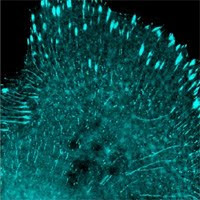The need for creating an extensive image library is deservingly recognized by this “GO” grant from the stimulus program awarded to the NIH by the federal government. The difficult part will be to maintain such an image center once the grant runs out. Will it be kept up-to-date and relevant, or left to collect dust on the old images? We wish that the program would be a great success and that the NIH money well spent.
Allele Biotech has applied to the same round of NIH grants with a related proposal that, rather than cell images in general, focuses more on cell differentiation/dedifferentiation through the use of iPS cells. Title: Foundation for “Subcellular Structureome” as Stem Cell Differentiation Parameters. Summary: The key question to be addressed is how to characterize differentiating stem cells along different lineages definitively and continuously, without disrupting or disturbing the differentiating cells. The broad and long-term goals are to find ways of describing stem cell differentiation in more detailed steps, thereby providing methods to predict and direct cell fate commitment.
Aim 1 Create a panel of cells that can be reprogrammed into induced pluripotent stem cells (iPSCs) with fluorescent protein (FP) fusion markers for each organelle
.Human fibroblasts and keratinocytes will be selected from a large collection of primary human cells, based on their ease to grow and transfect, number of potential cell passages, and potentials for reprogramming with induction reagents. A group of 24 subcellular localization polypeptides (LP) and FP fusion protein constructs currently offered by Allele Biotech will be stably transfected into the selected cell.
Aim 2 Characterize the morphological changes of subcellular structures during iPSC differentiation.
Transfected primary cells that stably express subcellular localization marker proteins will be induced with either current retroviral/lentiviral vectors based reprogramming cDNAs, or a non-integrating baculoviral vector under development at Allele Biotech. These cells, 48 lines in total, will be maintained and expanded under stem cell culture conditions, then induced to differentiate into chondracytes or keratinocytes as examples of cell fate. Morphology data will be analyzed and recorded at each known stage and additional “substage” to be defined in the process.
Aim 3 Correlate morphological changes to known molecular properties of each stage and provide a “signature” set of morphological changes for each stage of each lineage
Signature morphological changes, i.e. significantly different shape, location, sub-type, and copies of organelles in a cell compared to its immediate upstream stage, will be correlated to results obtained by standard expression assays at the RNA and protein levels.
Aim 4 Use the morphology parameters to establish more defined stages of cell fate commitments
Data points will be used to create a novel morphology-based cell fate commitment atlas, which will be very helpful in guiding the stem cell and regenerate medicine research at molecular biology, cell biology and physiology levels.
Aim 5 Construct more FP fusions as organelle-specific markers and combine with stage specific gene promoter driven markers
If necessary, we plan to identify more LPs as fusion marker partners after obtaining the initial set of data, and to expand the signature morphology image database. The database can be further complemented with stage-specific gene promoter driven FP images.
Weekly Promotion of Nov 30-Dec 6: 15% off luciferase assay kit ABP-PA-ABLA011 1000 reactions at only $
Reminder: Allele Biotech Spotlight Promo for ASCB Dec 09 Meeting is still on, order by Dec 9th on iPS and FP groups!
New Product of the Week of Nov 30-Dec 6: Allele Biotech’s ProperFold expression vector with fluorescent protein as indicator for proper protein folding, tracking, and purification. pORB-mWasabi+-sIRES-VSVG




No comments:
Post a Comment